Evaluating the Reaction to a Complex Rotated Object in the American Quarter Horse (Equus caballus)
Abstract
Simple Summary
Abstract
1. Introduction
2. Materials and Methods
3. Results
4. Discussion
5. Conclusions
Author Contributions
Funding
Institutional Review Board Statement
Informed Consent Statement
Data Availability Statement
Acknowledgments
Conflicts of Interest
References
- Camargo, F.; Gombeski, W.R.; Barger, P.; Jehlik, C.; Wiemers, H.; Mead, J.; Lawyer, A.; Gonzalez-Redondo, P. Horse-related injuries: Causes, preventability, and where educational efforts should be focused. Cogent Food Ag. 2018, 4, 14322168. [Google Scholar] [CrossRef]
- Meredith, L.; Ekman, R.; Brolin, K. Epidemiology of Equestrian Accidents: A Literature Review. Internet J. Allied Health Sci. Pract. 2018, 17, 9. [Google Scholar]
- Acton, A.S.; Gaw, C.E.; Chounthirath, T.; Smith, G.A. Nonfatal horse-related injuries treated in emergency departments in the United States, 1990–2017. Am. J. Emerg. Med. 2020, 38, 1062–1068. [Google Scholar] [CrossRef] [PubMed]
- Hawson, L.A.; McLean, A.N.; McGreevy, P.D. The roles of equine ethology and applied learning theory in horse related human injuries. J. Vet. Behav. 2010, 5, 324–338. [Google Scholar] [CrossRef]
- Krüger, L.; Hohberg, M.; Lehmann, W.; Dresing, K. Assesing the risk for major injuries in equestrian sports. BMJ Open Sport Exerc. Med. 2010, 4, 1–9. [Google Scholar] [CrossRef]
- Christensen, J.W.; Rundgren, M.; Olsson, K. Training methods for horses: Habituation to a frightening stimulus. Eq. Vet. J. 2010, 38, 439–443. [Google Scholar] [CrossRef]
- Leiner, L.; Fendt, M. Behavioural fear and heart rate responses of horses after exposure to novel objects: Effects of habituation. Appl. Anim. Behav. Sci. 2011, 131, 104–109. [Google Scholar] [CrossRef]
- Dai, F.; Heinzl, N.H.C.E.U.I.; Costa, E.D.; Canali, E.; Minero, M. Validation of a fear test in sport horses using infrared thermography. J. Vet. Behav. 2015, 10, 128–138. [Google Scholar] [CrossRef]
- Górecka-Bruzda, A.; Jastrzebska, E.; Sosnowska, Z.; Jaworksi, Z.; Jezierski, T.; Chruszczewski, M.H. Reactivity to humans and fearfulness tests: Field validation in Polish Cold Blood Horses. Appl. Anim. Behav. Sci. 2011, 133, 207–215. [Google Scholar] [CrossRef]
- Scopa, C.; Palagi, E.; Sighieri, C.; Baragli, P. Physiological outcomes of calming behaviors support the resilience hypothesis in horses. Sci. Rep. 2018, 8, 1–9. [Google Scholar] [CrossRef]
- Lansade, L.; Bouissou, M.F.; Erhard, H.W. Fearfulness in horses: A temerament trait stable across time and situation. Appl. Anim. Behav. Sci. 2008, 115, 182–200. [Google Scholar] [CrossRef]
- Noble, G.K.; Blackshaw, K.L.; Cowling, A.; Harris, P.A.; Sillence, M.N. An objective measure of reactive behavior in horses. Appl. Anim. Behav. Sci. 2013, 144, 121–129. [Google Scholar] [CrossRef]
- Borstel, U.K.v.; Duncan, I.J.H.; Lundin, M.C.; Keeling, L.J. Fear reactions in trained and untrained horses from dressage and show-jumping breeding lines. Appl. Anim. Behav. Sci. 2010, 125, 124–131. [Google Scholar] [CrossRef]
- King, T.; Hemsworth, P.H.; Coleman, G.J. Fear of novel and startling stimuli in domestic dogs. Appl. Anim. Behav. Sci. 2003, 82, 45–64. [Google Scholar] [CrossRef]
- Christensen, J.W.; Malmkvist, J.; Nielsen, B.L.; Keeling, L.J. Effects of a calm companion on fear reactions in naive test horses. Equine Vet. J. 2008, 40, 46–50. [Google Scholar] [CrossRef]
- Visser, E.K.; van Reenen, C.G.; van der Werf, J.T.; Schilder, M.B.H.; Knaap, J.H.; Barneveld, A.; Blokuis, H.J. Heart rate and heart rate variability during a novel object test and a handling test in young horses. Physio. Behav. 2002, 76, 289–296. [Google Scholar] [CrossRef]
- Borstel, U.K.v.; Pirsich, W.; Gauly, M.; Bruns, E. Repeatability and reliability of scores from ridden temperament tests conducted during performance tests. Appl. Anim. Behav. Sci. 2012, 139, 251–263. [Google Scholar] [CrossRef]
- Hanggi, E.B. Discrimination learning based on relative size concepts in horses (Equus caballus). Appl. Anim. Behav. Sci. 2003, 83, 201–213. [Google Scholar] [CrossRef]
- Hanggii, E.B. Rotated object recognition in four domestic horses (Equus caballus). J. Equine Vet. Sci. 2010, 30, 175–186. [Google Scholar] [CrossRef]
- Christensen, J.W.; Ahrendt, L.P.; Malmkvist, J.; Nicol, C. Exploratory behaviour towards novel objects is associated with enhanced learning in young horses. Sci. Rep. 2021, 14, 1428. [Google Scholar] [CrossRef]
- Bulens, A.; Sterken, H.; Van Beirendonk, S.; Van Thielen, J.; Driessen, B. The use of different objects during a novel object test in stabled horses. J. Vet. Behav. 2015, 10, 54–58. [Google Scholar] [CrossRef]
- Hall, C.A.; Cassaday, H.J.; Vincent, C.J.; Derrington, A.M. Cone excitation ratios correlate with color discrimination performance in the horse (Equus caballus). J. Comp. Psych. 2006, 120, 438–448. [Google Scholar] [CrossRef] [PubMed]
- McDonnell, S.M. The Equid Ethogram: A Practical Field Guide to Horse Behavior; Eclipse Press: Lexington, KY, USA, 2003; p. 99. [Google Scholar]
- R Core Team. R: A Language Environment for Statistical Computing R Function for Statistical Computing; R Foundation for Statistical Computing: Vienna, Austria; Available online: http://www.R-project.org (accessed on 24 March 2021).
- Available online: www.tidyverse.org (accessed on 24 March 2021).
- Thompson, K.; McGreevy, P.; McManus, P. A Critical Review of Horse-Related Risk: A Research Agenda for Safer Mounts, Riders and Equestrian Cultures. Animals 2015, 5, 561–575. [Google Scholar] [CrossRef] [PubMed]
- Lloyd, A.S.; Martin, J.E.; Bornett-Gauci, H.L.I.; Wilkinson, R.G. Horse personality: Variation between breed. Appl. Anim. Behav. Sci. 2008, 112, 369–383. [Google Scholar] [CrossRef]
- McGreevy, P.D.; Thomson, P.C. Differences in motor laterality between breeds of performance horses. Appl. Anim. Behav. Sci. 2006, 99, 183–190. [Google Scholar] [CrossRef]
- Caviello, R.F.; Titto, E.A.L.; Infante, P.; Leme-dos-Santos, T.M.d.C.; Neto, M.C.; Pereira, A.M.F.; Titto, C.G. Proposal and Validation of a Scale of Composite Measure Reactivity Score to Characterize the Reactivity in Horses During Handling. J. Eq. Vet. Sci. 2016, 47, 62–70. [Google Scholar] [CrossRef]
- Marsboll, A.F.; Christensen, J.W. Effects of handling on fear reactions in young Icelandic horses. Equine. Vet. J. 2014, 47, 615–619. [Google Scholar] [CrossRef]
- Hartmann, E.; Rehn, T.; Christensen, J.W.; Nielsen, P.P.; McGreevy, P. From the Horse’s Perspective: Investigating Attachment Behaviour and the Effect of Training Method on Fear Reactions and Ease of Handing—A Pilot Study. Animals 2021, 11, 457. [Google Scholar] [CrossRef]
 ) and the novel object placed during habituation to the novel object and rotation days.
) and the novel object placed during habituation to the novel object and rotation days.
 ) and the novel object placed during habituation to the novel object and rotation days.
) and the novel object placed during habituation to the novel object and rotation days.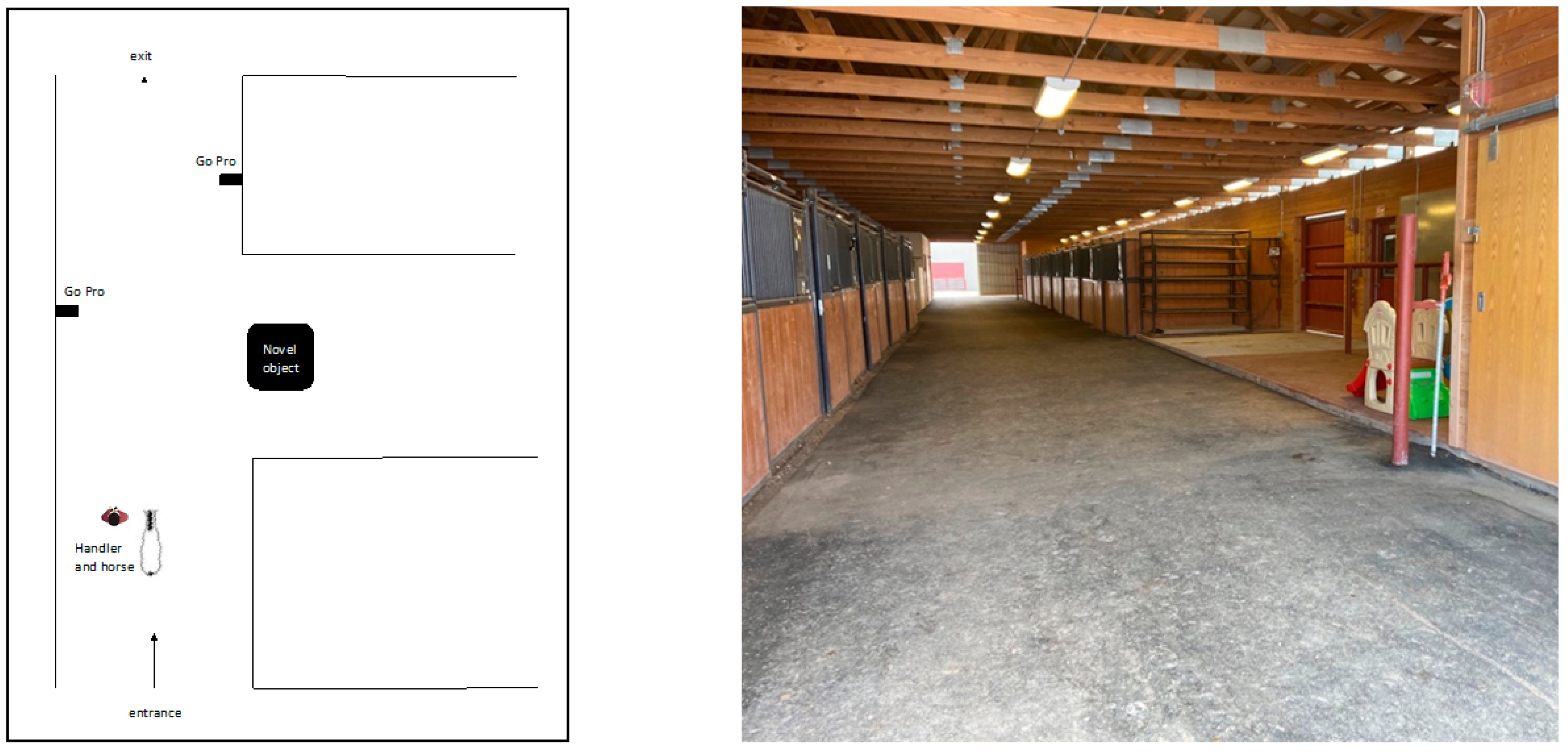
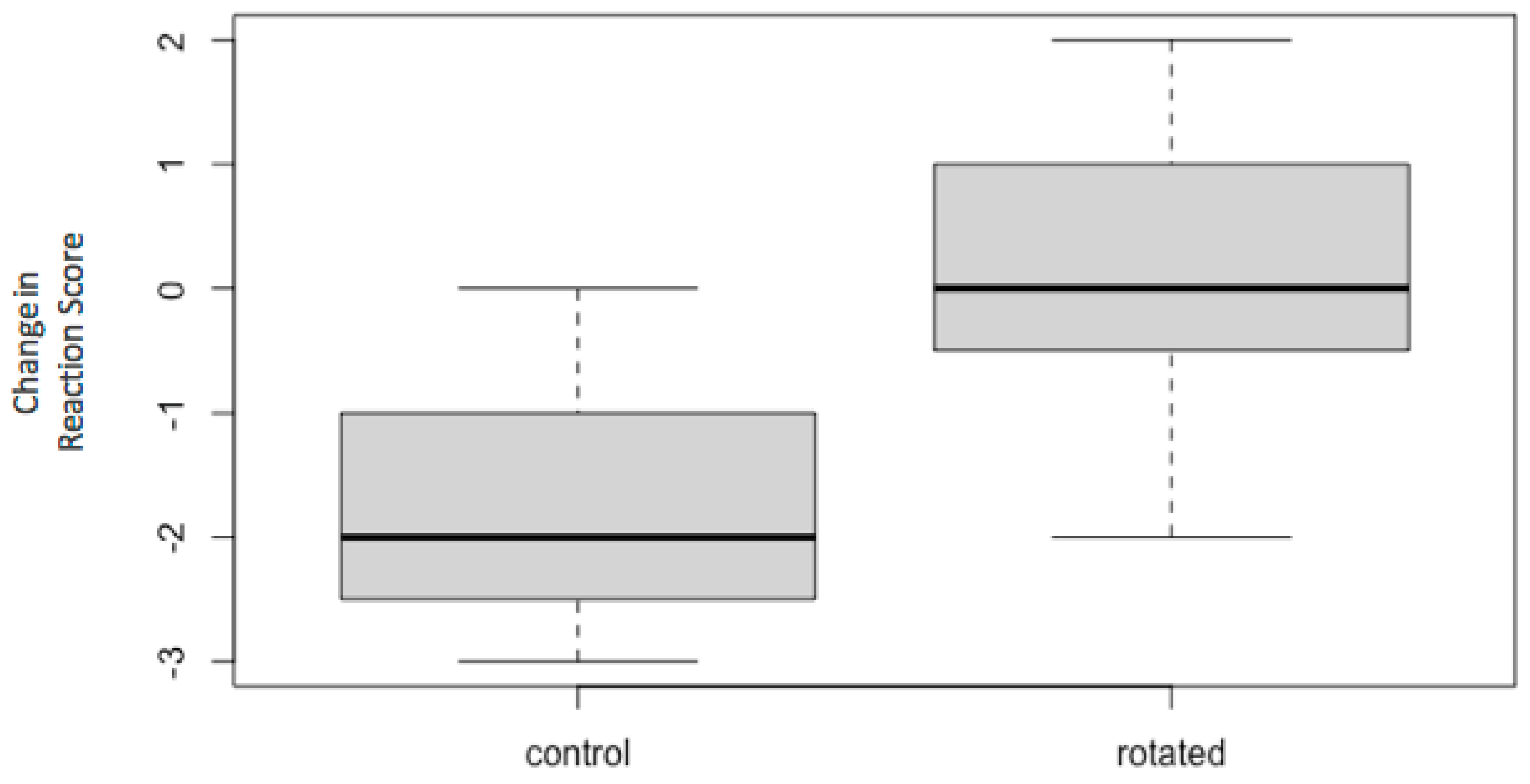
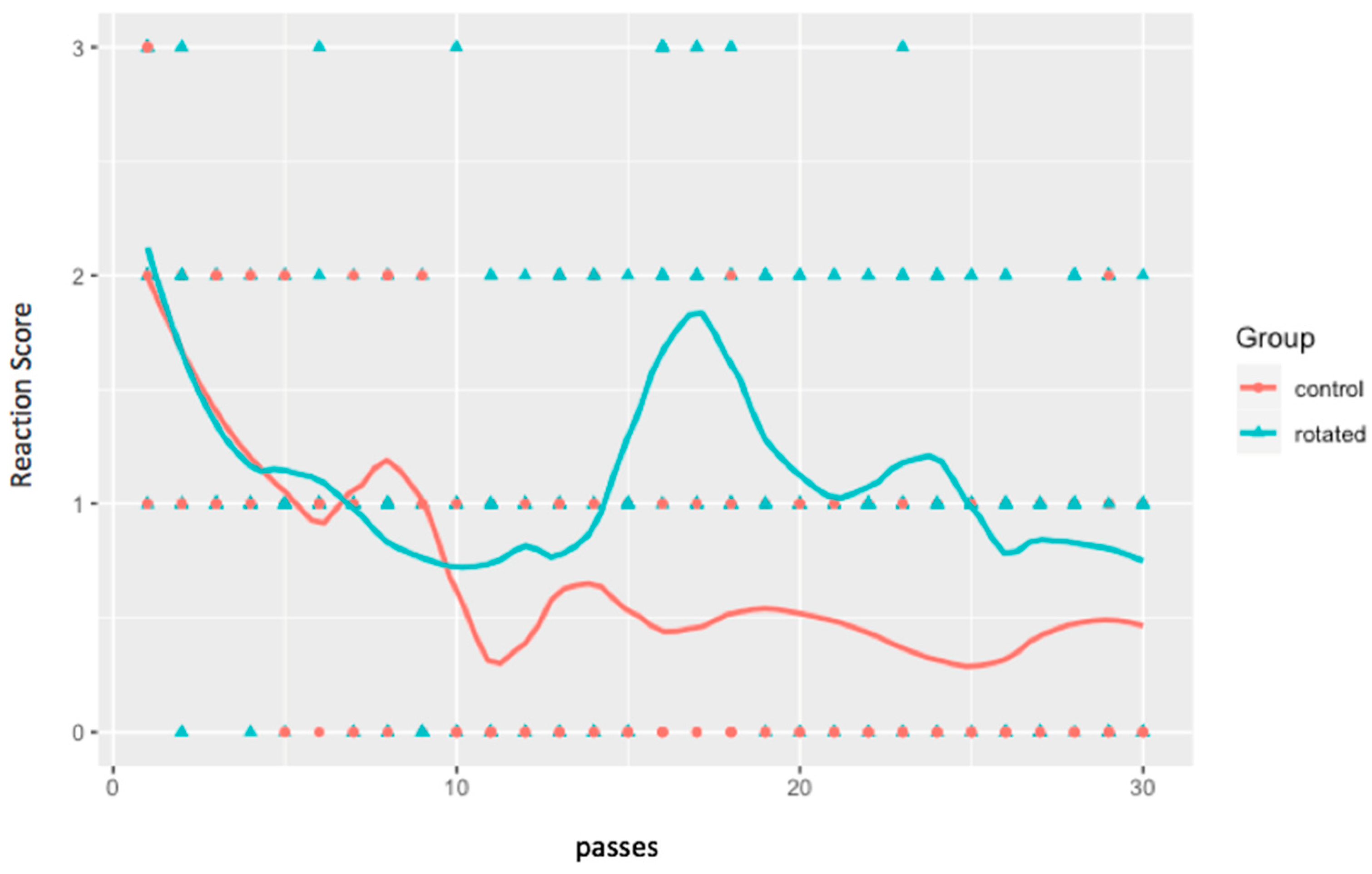
| Days 1–3 | Habituation to test area (novel object absent) | Control and Rotated groups | |
| 5 passes each day 15 total passes test area (Figure 1) without novel object | |||
| Days 4–6 | Habituation to the novel object | Control and Rotated groups | |
| 5 passes each day 15 total passes test area (Figure 1) with novel object in original position 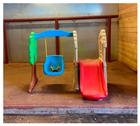 | |||
| Days 7–9 | Test days | Control group | Rotated group |
| 5 passes each day test area (Figure 1) with object in original position 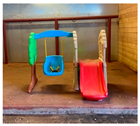 | 5 passes each day test area (Figure 1) with object in rotated position 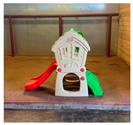 | ||
| Definitions of Behavioral Responses | |
|---|---|
| Behavioral Responses | Definition |
| ears focused on the object | ears are pointed toward the novel object |
| nostril flares | nostrils overly expanded (nose elongation) |
| neck raising | neck raised above normal headset and/or neck muscles tense |
| snorting | “short powerful exhale” [23] |
| avoid stop | avoiding the object by stopping, feet stop moving |
| avoid side | avoiding the object by evasive steps to the side, away from the object |
| avoid back | avoiding the object by evasive steps backwards, backing up |
| avoid flight | avoiding the object by jumping away in a sudden movement, feet moving faster a walk |
| Score 0–3 | Behavioral Responses Observed |
|---|---|
| 0 | No behavioral signs observed |
| 1 | Ears focused, nostril flares, and/or neck raising |
| 2 | Snorting and/or avoid stop |
| 3 | Avoid side, avoid back, avoid flight |
| Control | Rotated | ||||||
|---|---|---|---|---|---|---|---|
| Pass # | Mean | Min. | Max. | Mean | Min. | Max. | p-Value |
| 1 | −1.75 | −3 | 0 | 0.083 | −2 | 2 | 0.001 |
| 2 | −0.875 | −2 | 0 | 0.25 | −1 | 2 | 0.010 |
| 3 | −0.875 | −2 | 0 | 0.167 | −1 | 1 | 0.004 |
| 4 | −1 | −2 | 0 | 0.333 | −1 | 1 | 0.001 |
| 5 | −0.375 | −2 | 1 | -0.083 | −2 | 0 | 0.312 |
| 6 | −0.375 | −1 | 0 | -0.25 | −1 | 1 | 0.719 |
| 7 | −0.5 | −2 | 0 | 0.167 | −1 | 1 | 0.062 |
| 8 | −1 | −2 | 0 | 0.333 | −1 | 2 | 0.005 |
| 9 | −0.875 | −2 | 0 | 0.583 | −2 | 2 | 0.002 |
| 10 | −0.125 | −1 | 1 | 0.167 | −1 | 2 | 0.537 |
| 11 | 0 | 0 | 0 | 0.167 | −2 | 2 | 0.656 |
| 12 | 0.125 | −1 | 1 | -0.333 | −1 | 0 | 0.010 |
| 13 | −0.125 | −1 | 1 | 0.333 | −2 | 1 | 0.226 |
| 14 | −0.25 | −1 | 2 | 0.083 | −2 | 2 | 0.554 |
| 15 | 0 | −1 | 1 | -0.167 | −2 | 2 | 0.700 |
Publisher’s Note: MDPI stays neutral with regard to jurisdictional claims in published maps and institutional affiliations. |
© 2021 by the authors. Licensee MDPI, Basel, Switzerland. This article is an open access article distributed under the terms and conditions of the Creative Commons Attribution (CC BY) license (https://creativecommons.org/licenses/by/4.0/).
Share and Cite
Corgan, M.E.; Grandin, T.; Matlock, S. Evaluating the Reaction to a Complex Rotated Object in the American Quarter Horse (Equus caballus). Animals 2021, 11, 1383. https://doi.org/10.3390/ani11051383
Corgan ME, Grandin T, Matlock S. Evaluating the Reaction to a Complex Rotated Object in the American Quarter Horse (Equus caballus). Animals. 2021; 11(5):1383. https://doi.org/10.3390/ani11051383
Chicago/Turabian StyleCorgan, Megan Elizabeth, Temple Grandin, and Sarah Matlock. 2021. "Evaluating the Reaction to a Complex Rotated Object in the American Quarter Horse (Equus caballus)" Animals 11, no. 5: 1383. https://doi.org/10.3390/ani11051383
APA StyleCorgan, M. E., Grandin, T., & Matlock, S. (2021). Evaluating the Reaction to a Complex Rotated Object in the American Quarter Horse (Equus caballus). Animals, 11(5), 1383. https://doi.org/10.3390/ani11051383







